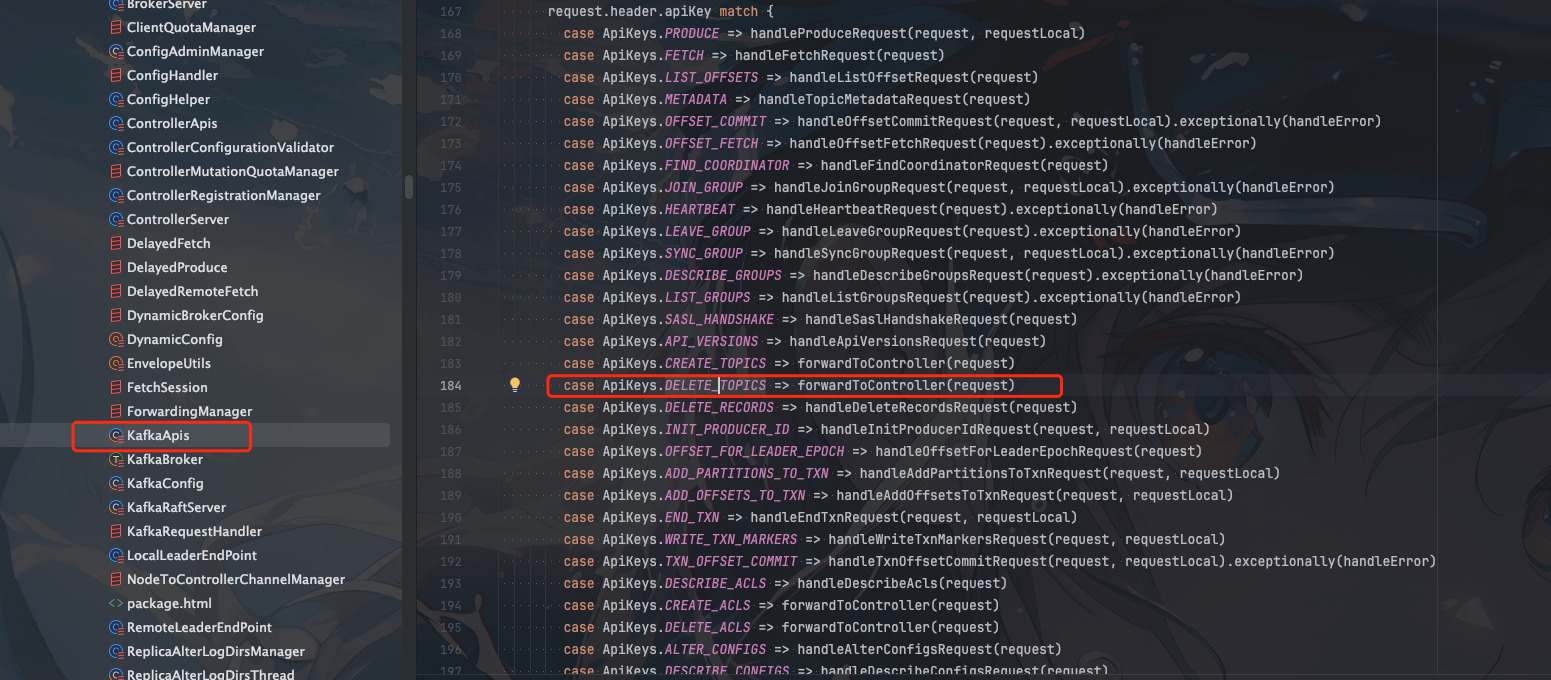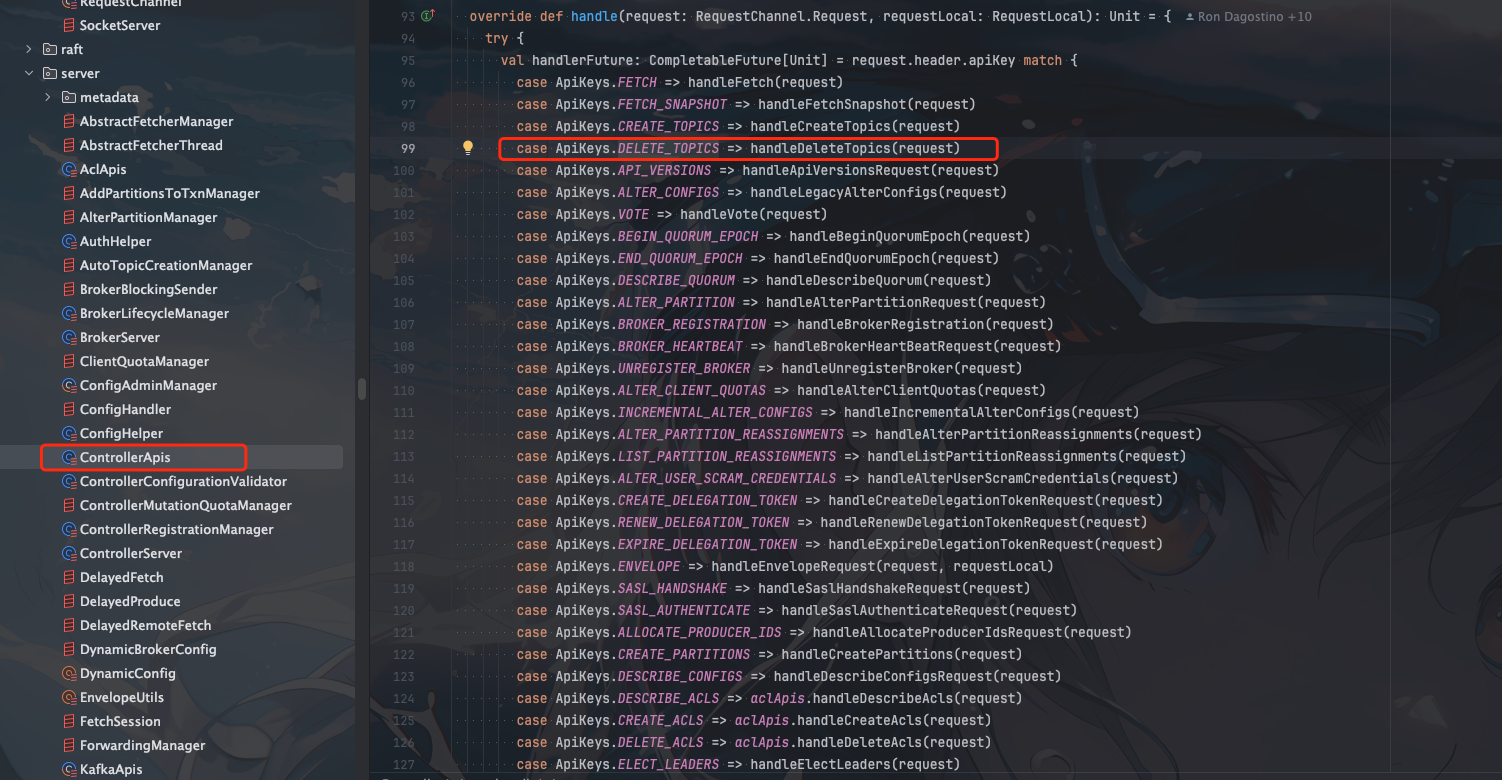kafka删除topic源码分析
client
kafka的所有client请求都在kafka.server.KafkaApis这个类进行分发
kafka.server.KafkaApis 这个类用的不是java语言实现的,主要用的是scala
请求类型基于scala强大的模式匹配语法进行分发的

serv
server的处理代码也是类似,请求分发主要是在ControllerApis

private def handleDeleteTopics(request: RequestChannel.Request): CompletableFuture[Unit] = {
val deleteTopicsRequest = request.body[DeleteTopicsRequest]
val controllerMutationQuota = quotas.controllerMutation.newQuotaFor(request, strictSinceVersion = 5)
val context = new ControllerRequestContext(request.context.header.data, request.context.principal,
requestTimeoutMsToDeadlineNs(time, deleteTopicsRequest.data.timeoutMs),
controllerMutationQuotaRecorderFor(controllerMutationQuota))
val future = deleteTopics(context,
deleteTopicsRequest.data,
request.context.apiVersion,
authHelper.authorize(request.context, DELETE, CLUSTER, CLUSTER_NAME, logIfDenied = false),
names => authHelper.filterByAuthorized(request.context, DESCRIBE, TOPIC, names)(n => n),
names => authHelper.filterByAuthorized(request.context, DELETE, TOPIC, names)(n => n))
future.handle[Unit] { (results, exception) =>
val response = if (exception != null) {
deleteTopicsRequest.getErrorResponse(exception)
} else {
val responseData = new DeleteTopicsResponseData()
.setResponses(new DeletableTopicResultCollection(results.iterator))
new DeleteTopicsResponse(responseData)
}
requestHelper.sendResponseMaybeThrottleWithControllerQuota(controllerMutationQuota, request, response)
}
}
实际的删除topic逻辑都封装在deleteTopics中,这里只是做了一些方法调用的参数组装,所以我们需要继续看看deleteTopics方法
def deleteTopics(
context: ControllerRequestContext,
request: DeleteTopicsRequestData,
apiVersion: Int,
hasClusterAuth: Boolean,
getDescribableTopics: Iterable[String] => Set[String],
getDeletableTopics: Iterable[String] => Set[String]
): CompletableFuture[util.List[DeletableTopicResult]] = {
// Check if topic deletion is enabled at all.
if (!config.deleteTopicEnable) {
if (apiVersion < 3) {
return CompletableFuture.failedFuture(new InvalidRequestException("This version does not support topic deletion."))
} else {
return CompletableFuture.failedFuture(new TopicDeletionDisabledException())
}
}
// The first step is to load up the names and IDs that have been provided by the
// request. This is a bit messy because we support multiple ways of referring to
// topics (both by name and by id) and because we need to check for duplicates or
// other invalid inputs.
val responses = new util.ArrayList[DeletableTopicResult]
def appendResponse(name: String, id: Uuid, error: ApiError): Unit = {
responses.add(new DeletableTopicResult().
setName(name).
setTopicId(id).
setErrorCode(error.error.code).
setErrorMessage(error.message))
}
val providedNames = new util.HashSet[String]
val duplicateProvidedNames = new util.HashSet[String]
val providedIds = new util.HashSet[Uuid]
val duplicateProvidedIds = new util.HashSet[Uuid]
def addProvidedName(name: String): Unit = {
if (duplicateProvidedNames.contains(name) || !providedNames.add(name)) {
duplicateProvidedNames.add(name)
providedNames.remove(name)
}
}
request.topicNames.forEach(addProvidedName)
request.topics.forEach {
topic => if (topic.name == null) {
if (topic.topicId.equals(ZERO_UUID)) {
appendResponse(null, ZERO_UUID, new ApiError(INVALID_REQUEST,
"Neither topic name nor id were specified."))
} else if (duplicateProvidedIds.contains(topic.topicId) || !providedIds.add(topic.topicId)) {
duplicateProvidedIds.add(topic.topicId)
providedIds.remove(topic.topicId)
}
} else {
if (topic.topicId.equals(ZERO_UUID)) {
addProvidedName(topic.name)
} else {
appendResponse(topic.name, topic.topicId, new ApiError(INVALID_REQUEST,
"You may not specify both topic name and topic id."))
}
}
}
// Create error responses for duplicates.
duplicateProvidedNames.forEach(name => appendResponse(name, ZERO_UUID,
new ApiError(INVALID_REQUEST, "Duplicate topic name.")))
duplicateProvidedIds.forEach(id => appendResponse(null, id,
new ApiError(INVALID_REQUEST, "Duplicate topic id.")))
// At this point we have all the valid names and IDs that have been provided.
// However, the Authorizer needs topic names as inputs, not topic IDs. So
// we need to resolve all IDs to names.
val toAuthenticate = new util.HashSet[String]
toAuthenticate.addAll(providedNames)
val idToName = new util.HashMap[Uuid, String]
controller.findTopicNames(context, providedIds).thenCompose { topicNames =>
topicNames.forEach { (id, nameOrError) =>
if (nameOrError.isError) {
appendResponse(null, id, nameOrError.error())
} else {
toAuthenticate.add(nameOrError.result())
idToName.put(id, nameOrError.result())
}
}
// Get the list of deletable topics (those we can delete) and the list of describable
// topics.
val topicsToAuthenticate = toAuthenticate.asScala
val (describable, deletable) = if (hasClusterAuth) {
(topicsToAuthenticate.toSet, topicsToAuthenticate.toSet)
} else {
(getDescribableTopics(topicsToAuthenticate), getDeletableTopics(topicsToAuthenticate))
}
// For each topic that was provided by ID, check if authentication failed.
// If so, remove it from the idToName map and create an error response for it.
val iterator = idToName.entrySet().iterator()
while (iterator.hasNext) {
val entry = iterator.next()
val id = entry.getKey
val name = entry.getValue
if (!deletable.contains(name)) {
if (describable.contains(name)) {
appendResponse(name, id, new ApiError(TOPIC_AUTHORIZATION_FAILED))
} else {
appendResponse(null, id, new ApiError(TOPIC_AUTHORIZATION_FAILED))
}
iterator.remove()
}
}
// For each topic that was provided by name, check if authentication failed.
// If so, create an error response for it. Otherwise, add it to the idToName map.
controller.findTopicIds(context, providedNames).thenCompose { topicIds =>
topicIds.forEach { (name, idOrError) =>
if (!describable.contains(name)) {
appendResponse(name, ZERO_UUID, new ApiError(TOPIC_AUTHORIZATION_FAILED))
} else if (idOrError.isError) {
appendResponse(name, ZERO_UUID, idOrError.error)
} else if (deletable.contains(name)) {
val id = idOrError.result()
if (duplicateProvidedIds.contains(id) || idToName.put(id, name) != null) {
// This is kind of a weird case: what if we supply topic ID X and also a name
// that maps to ID X? In that case, _if authorization succeeds_, we end up
// here. If authorization doesn't succeed, we refrain from commenting on the
// situation since it would reveal topic ID mappings.
duplicateProvidedIds.add(id)
idToName.remove(id)
appendResponse(name, id, new ApiError(INVALID_REQUEST,
"The provided topic name maps to an ID that was already supplied."))
}
} else {
appendResponse(name, ZERO_UUID, new ApiError(TOPIC_AUTHORIZATION_FAILED))
}
}
// Finally, the idToName map contains all the topics that we are authorized to delete.
// Perform the deletion and create responses for each one.
controller.deleteTopics(context, idToName.keySet).thenApply { idToError =>
idToError.forEach { (id, error) =>
appendResponse(idToName.get(id), id, error)
}
// Shuffle the responses so that users can not use patterns in their positions to
// distinguish between absent topics and topics we are not permitted to see.
Collections.shuffle(responses)
responses
}
}
}
}
核心删除逻辑
controller.deleteTopics